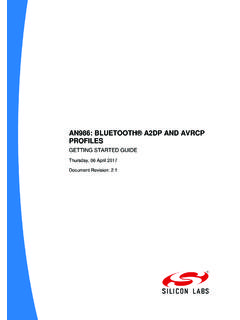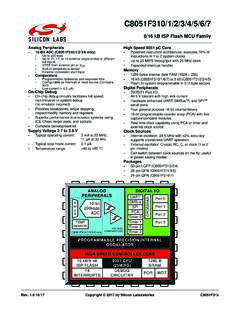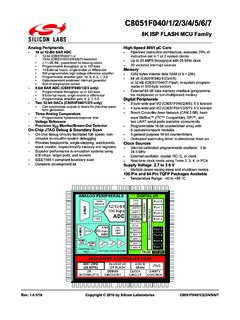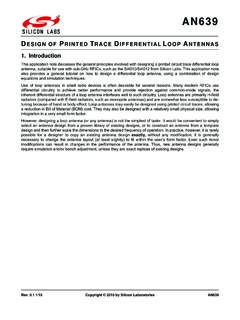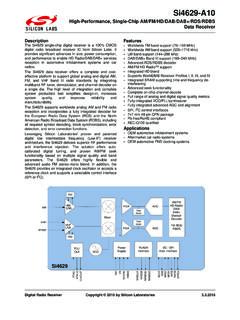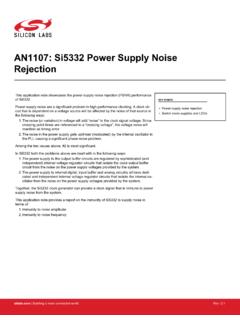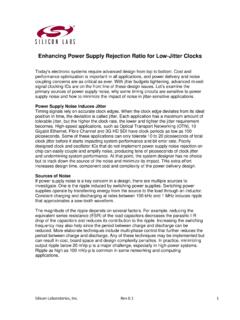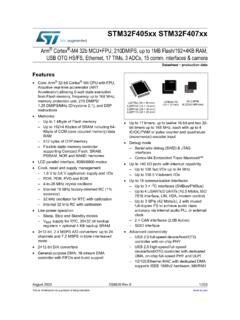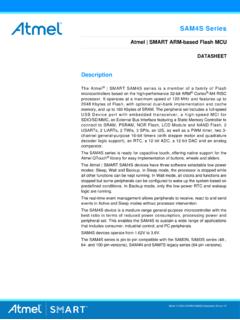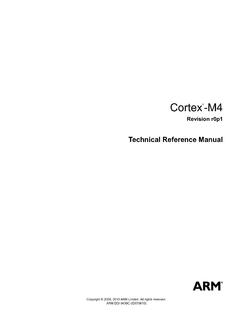Transcription of ARM Cortex -M3 & M4 MCU Architecture - Silicon Labs
1 AR M C o r t e x - M 3 & M 4 M C U Ar c h i t e c t u r e Introduction Many embedded developers are familiar with the ARM Cortex processor Architecture , but few have the opportunity to become intimately acquainted enough of this popular Architecture to take full advantage of its unique features and capabilities. This is especially true for the new ARM Cortex -M4 processor, which boasts an improved Architecture , native digital signal processing (DSP) capabilities and an optional floating-point accelerator, which a savvy programmer or hardware engineer can exploit to their ad- vantage. Let's take a closer look at some of the more interesting (and often-overlooked) features found in Cortex -M3 based microcontrollers (MCUs) as well as new M4 variants.
2 Since many target applications for Cortex -M based MCUs are portable and derive their power from bat- teries or energy harvesting systems, most of the ideas we will explore involve techniques for reducing a design's overall energy consumption. In many cases, however, these energy conservation techniques are also helpful tools for designing processor-optimized applications that provide: More cost-effective solutions More processing margin available for upgrades and new features Performance and features that help products stand out in crowded markets. ARM Cortex Basics Much like the original 16-bit processor cores created by Advanced RISC Machines (ARM) in the 1980s, the ARM Cortex series is based on a Harvard-style RISC machine with a modest Silicon footprint that en- ables high performance as well as code and memory efficiency.
3 The Architecture has evolved considera- bly over the past decade, branching into three distinct sub-families (or profiles) created to meet the re- quirements of a particular application space: A-profile products are optimized for high-performance open application platforms R-profile processors include features for enhanced performance and reliability in real-time applications The M-profile processor series was developed for use in deeply-embedded MCUs in applica- tions where performance must be balanced with energy efficiency and low solution cost. Popular applications for the Cortex M series include smart metering, human interface de- vices, automotive and industrial control systems, white goods, consumer electronics prod- ucts and medical instrumentation.
4 Silicon Labs Rev 1. The Cortex -M3 vs. Cortex -M4 Story The idea behind the Cortex -M3 Architecture was to design a processor for cost-sensitive applications while providing high-performance computing and control1. These applications include automotive body sys- tems, industrial control systems and wireless networking/sensor products. The M3 series introduced sev- eral important features to the 32-bit ARM processor Architecture including: Non-maskable interrupts Highly-deterministic, nested, vectored interrupts Atomic bit manipulation Optional memory protection (MPU). In addition to excellent computational performance, the Cortex -M3 processor's advanced interrupt structure ensures prompt system response to real-world events while still offering low dynamic and static power consumption2.
5 (a) (b). Figure 1. Comparison of the Cortex -M3 and M4 Processor Cores. The Cortex -M3 and M4 processors share many common elements including advanced on-chip debug features and the ability to execute the full ARM instruction set or the subset used in THUMB2 proces- sors. The Cortex -M4 processor's instruction set is enhanced by a rich library of efficient DSP features in- cluding extended single-cycle cycle 16/32-bit multiply-accumulate (MAC), dual 16-bit MAC instructions, optimized 8/16-bit SIMD arithmetic and saturating arithmetic instructions. Overall, the most noticeable difference between M3 and M4 is the optional single-precision (IEEE-754) Floating Point Unit (FPU) avail- able with the M4.
6 Serial Secrets Stimulate Slick Solutions The success or failure of an embedded design often rests on finding the right balance between system performance, energy consumption and solution cost. In many cases, developers can use the Cortex -M. processor's unique features to optimize for product cost or energy appetite while maintaining, or even improving, its performance. For example, the Cortex -M core has native serial I/O capabilities that can be Silicon Labs Rev 2. used to save energy, simplify development and free up peripherals to be used for other application tasks. Besides the traditional Serial Wire Debug functions, ARM Cortex -M based microcontrollers also offer an instrumentation trace interface through its single-pin Serial Wire Viewer Output (SWO)3, as shown in Figure 2.
7 This port can be used to pass printf-format debug messages directly to application code. SWO allows the debug messages to be viewed directly from any standard IDE. Additionally, these mes- sages can be viewed through a standalone SWO viewer such as Segger's J-Link SWO Viewer software4 or the energyAware Commanderfrom Silicon Labs4. Since the SWO output is built into the core HW itself, this is an inherent benefit of the Cortex -M core. SWO doesn't waste any of the MCU's regular UARTs, which might already be committed to the application. Figure 2. The Dedicated ARM Cortex SWO Interface Saves I/O Pins and Speeds Up Debugging. Another important advantage of SWO-based debugging is that it allows the MCU to maintain an active debug connection when it enters its lowest sleep modes where, in most cases, the logic for traditional debug connections is inoperative.
8 The instrumentation trace of the SWO can also be used for sampling the program counter to help IDEs create statistics on how much time is spent in each of the program functions. These statistics can be combined with current measurements to help fine-tune a design's en- ergy consumption. Cortex -M based MCU vendors are beginning to recognize this benefit, and some manufacturers have already incorporated power profile and current measurement hardware into their development plat- forms for this purpose. For example, all starter and development kits for the EFM32 Gecko MCUs from Silicon Labs include live power measurement outputs, which can be coupled with the program trace in the energyAware Profiler tool6.
9 Figure 3 shows how this allows the designer to pinpoint which program functions are the highest energy drains and allows fast debugging of other energy-related problems. Silicon Labs Rev 3. Figure 3. Software and hardware tools that pinpoint which functions are using the most current eliminate the need oscilloscopes and multimeters and enable fast debugging. Sleep Smart and Make Every W Count The ARM Cortex -M processor's Sleep-on-Exit instruction is another twofer feature that can save both CPU cycles and energy. This is especially useful in interrupt-driven applications where the processor spends most of its time either running interrupt handlers or sleeping between interrupt events.
10 When entering an interrupt service routine (ISR), the MCU must spend several instruction cycles pushing the present thread's state onto the stack and then popping it upon return. In applications where the pro- cessor returns directly to its sleep after an ISR, a conventional MCU must still recover its stored state in- formation before the thread code can put the device to sleep. Likewise, its state must be pushed to the stack again when the next interrupt wakes the device. When an ARM Cortex -M based microcontroller's Sleep-on-Exit is enabled, the device will enter sleep di- rectly after the ISR finishes without returning to the thread (see Figure 4). This preserves the processor in the interrupt state, saving the precious machine cycles normally required to push the normal state Silicon Labs Rev 4.

